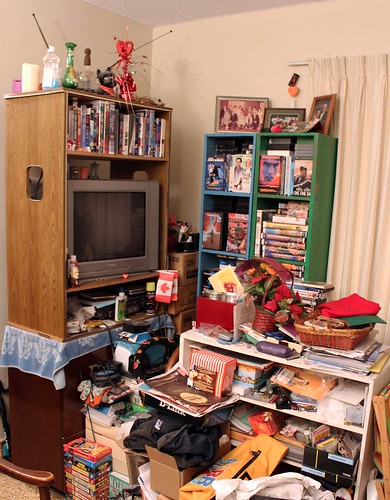‘I’m a gatherer’: The experience of compulsive hoarding
By Tejay Gardiner
EDMONTON — Dr. Mary Haase points to an enlarged reprint of an old photograph on her desk. The picture is of a woman with three little girls standing at her side.
“I’m the little girl on the right-hand side,” said the MacEwan University psychiatric nursing professor. “I lived next door to Mrs. Jackson… and she had OCD.”
This early interaction marked the beginning of Haase’s fascination with compulsive behaviours.
Today, Haase and her two colleagues, Dr. Irene Coulson and Melissa Watkins, are gaining recognition for their research in compulsive hoarding. The trio examined the experience of people who hoard, and effective and innovative ways to treat the compulsion.

Part of Jane Sadoway's collection of DVDs and videos, stored in her living room. Sadoway is a bargain hunter and self-proclaimed "gatherer." She attends various groups and has been assigned someone to help with her hoarding compulsion. Photograph by Tejay Gardiner. Wednesday, Dec. 7, 2011.
Haase is clearly intrigued by and deeply engaged in her research, but her most interesting finding so far is the taboo around compulsive disorders.
“OCD is secretive,” she said. “The average person takes 17 years from the first symptoms to diagnosis, because they hide it.”
Part of Haase’s earlier research focused on comparing “ordinary” behaviour with “compulsive” behaviour. She explains that satisfying the compulsion is similar to the “high” a drug addict feels.
“People who hoard,” Haase said, “the ones who go out and acquire, get a ‘high’ from acquiring.
“So when they find that bargain, or they find something cheap, or they find that find in the trash bin, they’re thrilled,” she said.
There are three types of hoarders: Those who actively go out and acquire, those who hold onto things that come into their possession, and Diogenes hoarders, who are typically older and have more extreme symptoms.
Often people who hoard have experienced loss. It can be the loss of personal items or the loss of a loved one that triggers the compulsion.
Jane Sadoway, who worked with the MacEwan research team, calls herself a “gatherer.”
When she was 12 years old, her mother gave away her toys during a family move without her knowledge. One doll in particular was very meaningful to Sadoway and she feels this loss triggered her hoarding behaviour.
She can find a use for almost anything she comes across. She is a bargain hunter and collector, and she said when she watches the television show Consumed she sees herself.
“I once bought a bag of 10 items for 28 cents,” she said.
She also talks a lot about saving things for her daughter and passing them on. If a neighbour or friend needs something she will find it for them. Take for example, the small box of hollyhock flower seeds on her desk, which she collected for her neighbour.
Sadoway attends various groups and has been assigned a counsellor to help her curb her hoarding behaviour. The groups have been helpful, she said, and offers an example of how she can talk herself out of hanging on to things.
“I had an ice cube tray the other day,” she said, “and I was trying to decide what to do with it.” She was tempted to keep it, thinking she could use this one for storing jewelry, since she had one in the freezer already.
“So I had to talk myself out of keeping it,” she said.
And what did Sadoway tell herself? She told herself that she didn’t need it, that she could use something else to store jewelry, that she doesn’t use ice much, and that she doesn’t have anyone to keep it for and pass on to. With that conversation, she was able to throw away the tray.
It sounds like an exhausting process, but it is one that Haase also encourages. Simply going into someone’s house and decluttering, or in extreme cases evicting a person from his or her home, doesn’t address the real issues of why people hoard. Instead it can cause more stress and lead the individual to another round of hoarding.
“It’s really difficult to let go of something,” Haase said. “It would be like me going into your house and asking you to throw away all the photographs of your mom and dad.
“Would you be OK with that?”
Haase hopes her team’s research will address these inadequate solutions and offer a better alternative to effectively treat hoarding compulsion.
The next phase of their research will look at people who live with hoarders.
Hear Jane Sadoway talk about her life and her home:












Great story. Loved the slideshow.
While we may feel somewhat sorry for her it was nice to hear her say that she was ok with herself. With limited words you’ve captured the story very well! Interesting article with interesting video and good photos!